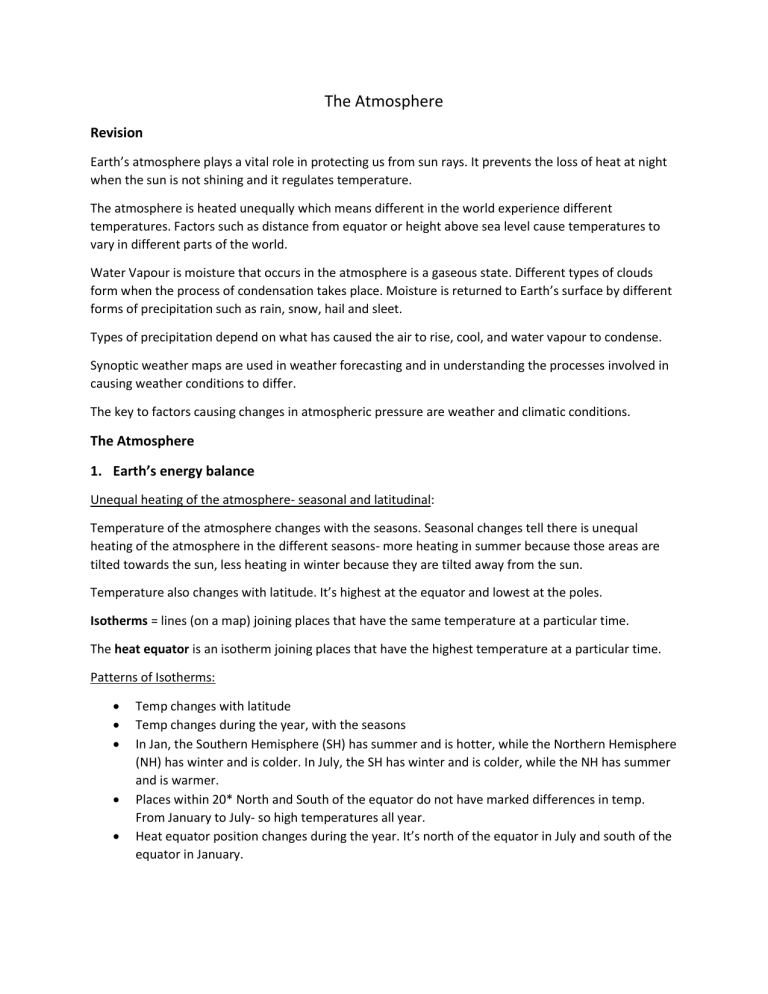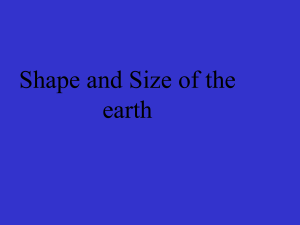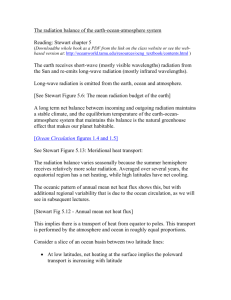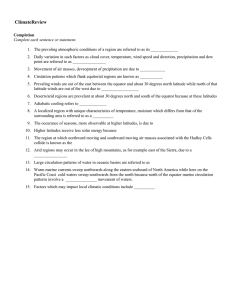
The Atmosphere Revision Earth’s atmosphere plays a vital role in protecting us from sun rays. It prevents the loss of heat at night when the sun is not shining and it regulates temperature. The atmosphere is heated unequally which means different in the world experience different temperatures. Factors such as distance from equator or height above sea level cause temperatures to vary in different parts of the world. Water Vapour is moisture that occurs in the atmosphere is a gaseous state. Different types of clouds form when the process of condensation takes place. Moisture is returned to Earth’s surface by different forms of precipitation such as rain, snow, hail and sleet. Types of precipitation depend on what has caused the air to rise, cool, and water vapour to condense. Synoptic weather maps are used in weather forecasting and in understanding the processes involved in causing weather conditions to differ. The key to factors causing changes in atmospheric pressure are weather and climatic conditions. The Atmosphere 1. Earth’s energy balance Unequal heating of the atmosphere- seasonal and latitudinal: Temperature of the atmosphere changes with the seasons. Seasonal changes tell there is unequal heating of the atmosphere in the different seasons- more heating in summer because those areas are tilted towards the sun, less heating in winter because they are tilted away from the sun. Temperature also changes with latitude. It’s highest at the equator and lowest at the poles. Isotherms = lines (on a map) joining places that have the same temperature at a particular time. The heat equator is an isotherm joining places that have the highest temperature at a particular time. Patterns of Isotherms: Temp changes with latitude Temp changes during the year, with the seasons In Jan, the Southern Hemisphere (SH) has summer and is hotter, while the Northern Hemisphere (NH) has winter and is colder. In July, the SH has winter and is colder, while the NH has summer and is warmer. Places within 20* North and South of the equator do not have marked differences in temp. From January to July- so high temperatures all year. Heat equator position changes during the year. It’s north of the equator in July and south of the equator in January. 2. The significance of Earth’s axis around the sun The sun is the source of energy. The sun’s energy is transferred by means of waves, the is kind of energy is called radiation. Radiation from the sun is solar radiation. Wavelength of radiation is related to the temp of the radiating body. The sun has a short wavelength as it is a very hot radiating body. 3. Earth’s revolution around the sun on its axis As Earth moves around the sun, Earth’s axis always points the same way at 23 ½* to the vertical. The parallelism of the axis is the constant alignment of the axis. 21 or 22 Dec and 21 June are called solstices; summer and winter. At the solstices, one hemisphere is tilted toward the sun and has summer, while the other is tilted away from the sun and has winter. 21 March and 23 Sept are called equinoxes; spring and autumn. At the equinoxes, neither hemisphere is tilted towards or away from the sun. Due to the tilt of earth’s axis and the shape of Earth’s orbit around the sun, different places on earth will experience latitudinal and seasonal differences in heat energy. 4. Effect of Earth’s revolution on the length of day and the angle of the sun’s rays: Half of Earth is always lit by the sun experiencing day while the other half is dark experiencing night. Circle of illumination is the line between the light and dark halves of Earth. At the solstices, day is equal to night only at the equator, while day is longer in the hemisphere tilted towards the sun ( summer) and shorter in the other (winter). Places towards the poles 66 ½* north and south, day is 24 hours long in the summer and night is 24 hours long in the winter. Changes in the angle of the sun’s rays: 21 June = noon angle of the sun is 90* at the tropic of cancer, and lower elsewhere. 21 Dec = noon angle of the sun is 90* at the tropic of Capricorn, and lower elsewhere. 20 March and 22 Sept = noon angles of 90* at the equator, and lower elsewhere. Sun’s rays never directly overhead any place north of the tropic of cancer and south of the tropic of capricorn. During the year, the sun appears to move from being directly above the tropic of cancer to being directly above the tropic of Capricorn. This called the apparent migration of the sun. At each latitude, the noon angle of the sun changes during the year. Rotation vs Revolution Earth revolves counter clockwise around the sun once every 365 ¼ days. Earth makes a complete counter clockwise rotation (spins on its axis) once in each 24 hour period. This is why the sun appears to rise in the east and set in the west. 5. Latitudinal imbalances in incoming and outgoing radiation Ideal conditions do not exist everywhere on Earth. More radiation is received at low latitudes than at high, the same amount of radiation should leave each place as is received if balance is to be achieved. A radiation surplus takes place when more radiation comes in than leaves, while a radiation deficit takes place when more radiation leaves than is received. The areas of surplus are areas of low latitudes and areas of deficits are areas of high latitudes Looking at annual incoming radiation, the amount of surplus is equal to the amount of deficit which confirms that incoming and outgoing radiation are balanced for Earth as a whole. 6. Transfer of energy towards the poles to bring energy balance. There are 2 mechanisms responsible for the transfer of energy from areas of surplus near the equator to areas of deficit further towards the poles: Winds- warm, moist air moves pole wards from the tropics, carrying heat energy to higher latitudes. Ocean currents- moving streams of water in the oceans called currents, move warm water to colder places and bring colder water to warmer places Without these 2 transfers the ocean around Europe world freeze making shipping and fishing impossible and world climates would be different and people would be distributed differently across the globe. Surface Currents: They flow in the upper 400m of water moving in circular patterns called gyres. In each ocean- clockwise in the Northern Hemisphere and anticlockwise in the Southern Hemisphere. Surface currents carry warm water towards poles and cold water towards equator. Energy transfer by ocean: Deep ocean currents- Driven by differences in the density of water. The movement of these ocean currents is thermohaline circulation because water density depends on its temperature (thermo) and its salinity (haline). Colder, saltier water is denser than warmer, less salty water. Thermohaline circulation begins in the North Atlantic Ocean. The process of thermohaline circulation Near the Poles some water freezes, as all the salt doesn’t freeze with it, the cold but unfrozen water becomes saltier and denser Dense water sinks to the ocean floor, and more water moves in to replace it, setting the currents in motion. Cold water in this huge circulation system flows very slowly at deep levels. Some of it travelling as far as the cold waters of the Southern Atlantic Ocean near Antarctica. Near the equator, the water warms, becomes less dense, rises and flows towards the poles again. Cold currents are about 400m below the surface and warm currents are about 200m below the surface. Thermohaline circulation is the movement of deep ocean currents driven by differences in the density of water. Energy Transfer by wind: Wind is air that moves horizontally across Earth. In each hemisphere, some winds blow towards the poles from the tropics carrying heat energy to higher latitudes. Other winds blow from polar regions moving cold air to lower latitudes. These form part of the Global Circulation. Global Air Circulation 1. Unicellular model of global circulation The global circulation of the atmosphere would transfer heat from low latitudes to high latitudes in two huge convention cells, one in each hemisphere. There is one cell of circulation in each hemisphere, this is a one-cell model or unicellular model of global circulation. Warm air rises at the equator and moves towards the poles. At the poles, air becomes colder and sinks Cold air travels back to the equator, completing the convection system Vertical and horizontal air movement Horizontal and vertical movements of air are linked. When air subsides from above, it diverges When air converges, it must rise. In the upper air, the ascending air must diverge. These movements of an air have an impact on the weather. Rising air cools and is likely to lead to the formation of cloud and rain. Descending air warms and is associated with dry conditions. 2. World Pressure Patterns Atmospheric pressure: it’s the force per unit area exerted against a surface by the weight of a column of air above that surface. Reasons for horizontal variations in pressure Warm air expands. Gas molecules spread out and density decreases. Resulting in the column of warm air having less weight and its pressure will be low. Cold air contracts. Gas molecules are packed more closely together and density increases. Resulting in the column of air having more weight and its pressure will be high. When air rises above a surface, the pressure at the surface will be low, when air subsides over a surface, the pressure at the surface will be high. The correlation between air pressure and altitude, higher altitudes result in less air pressure while lower altitudes result in more air pressure. 3. Main Pressure Belts Pressure is arranged in belts of high pressure and low pressure that run from east to west across Earth. ITCZ = Inter-tropical Convergence Zone Air moves from a high to low Subtropical high pressure belts are also called horse latitudes. The tri-celluar model has patterns of ascent and descent, of convergence and divergence. There three individual cells in each hemisphere. Each cell has four components, two of horizontal movement and two of vertical movement. They’re the same in each hemisphere. Hadley Cell Hot air rises from surface, it cool, forming tall cumulonimbus clouds. The risen air diverges in the upper air, moving pole ward, and cools further. At 30° north and south, the cooled air subsides At the surface, subsiding air diverges and some of this air returns to the equator, completing the Hadley cell. Ferrel Cell Air subsides at 30°, warms and diverges at the surface. Some of the air moves pole wards At 60°, pole ward moving warmer air meets cold air that is moving equator ward from the pole. Convergence cause air to rise Rising air diverges in the upper air. Some moves equator ward and subsides at 30°, completing the Ferrel Cell Polar Cell Cold air subsides over the pole At the surface it moves equator ward and meets warm air from the Ferrel Cell at about 60° Converging air at 60° rises Air then moves pole ward, completing the Polar Cell 4. Winds related to regional and local air movements Monsoons means “seasons”, the term is used to denote a seasonal reversal of wind direction. It’s a wind whose direction reverses in summer and winter, the change in direction with the seasons is a response to changes in temperature and pressure from season to season. Pressure and wind patterns in Jan. In winter the Asian land mass becomes very cold, and pressure is high The ocean does not get as cold as the interior of the Asian land mass because water holds the heat received in summer better than the land does. So pressure is lower over the ocean than over the interior of the continent Cold air blows outward from the high pressure in the interior and it subsides and produces no rain. Pressure and wind patterns in July In summer low pressure develops in the interior because of extreme heating of the large Asian land mass Water of the ocean does not heat up as much as the land in summer. So pressure is lower over the land than over the ocean Moist air from the warm oceans to the south is drawn into the interior by low pressure there Convergence and the high Himalayas cause warm moist air to rise, cool and produce heavy rain




